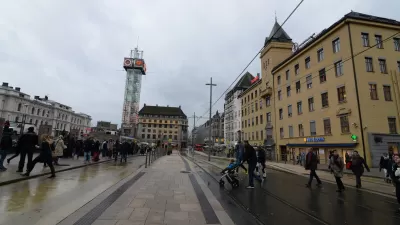Many streets and cities are designed for vehicles instead of for pedestrians. But policies and programs in cities around the world, and even in the United States, might be signaling a shift in priorities.

Richard Conniff takes a look at recent efforts to make cities better places for pedestrians. In Europe, car restrictions and bans are planned or have been instituted in Oslo, Madrid, and Paris, even in the face of public opposition, he says:
Yes, car owners are furious. That's because they have mistaken their century-long domination over pedestrians for a right rather than a privilege. The truth is that cities are not doing nearly enough to restore streets for pedestrian use, and it's the pedestrians who should be furious.
In the United States, the notion that streets are for cars is exemplified by level of service standards based on vehicle throughputs. The result is increased air pollution, more expensive cities, and streetscapes that are not conducive to more sustainable modes of travel. "Urban walking has thus deteriorated from a civilized pleasure to an overheated, unshaded, traffic-harried race to a destination," laments Conniff.
Still, he points to examples of change happening at the grassroots level, including the Walk [Your City] program, which promotes wayfinding and walkability, and the Better Block Foundation, an organization that helps communities with placemaking and neighborhood development projects.
"In many of the major cities of the world, it has begun to dawn even on public officials that walking is a highly efficient means of transit, as well as one of the great underrated pleasures in life," says Conniff.
FULL STORY: The Pedestrian Strikes Back

Study: Maui’s Plan to Convert Vacation Rentals to Long-Term Housing Could Cause Nearly $1 Billion Economic Loss
The plan would reduce visitor accommodation by 25,% resulting in 1,900 jobs lost.

Alabama: Trump Terminates Settlements for Black Communities Harmed By Raw Sewage
Trump deemed the landmark civil rights agreement “illegal DEI and environmental justice policy.”

Why Should We Subsidize Public Transportation?
Many public transit agencies face financial stress due to rising costs, declining fare revenue, and declining subsidies. Transit advocates must provide a strong business case for increasing public transit funding.

Paris Bike Boom Leads to Steep Drop in Air Pollution
The French city’s air quality has improved dramatically in the past 20 years, coinciding with a growth in cycling.

Why Housing Costs More to Build in California Than in Texas
Hard costs like labor and materials combined with ‘soft’ costs such as permitting make building in the San Francisco Bay Area almost three times as costly as in Texas cities.

San Diego County Sees a Rise in Urban Coyotes
San Diego County experiences a rise in urban coyotes, as sightings become prevalent throughout its urban neighbourhoods and surrounding areas.
Urban Design for Planners 1: Software Tools
This six-course series explores essential urban design concepts using open source software and equips planners with the tools they need to participate fully in the urban design process.
Planning for Universal Design
Learn the tools for implementing Universal Design in planning regulations.
Smith Gee Studio
Alamo Area Metropolitan Planning Organization
City of Santa Clarita
Institute for Housing and Urban Development Studies (IHS)
City of Grandview
Harvard GSD Executive Education
Toledo-Lucas County Plan Commissions
Salt Lake City
NYU Wagner Graduate School of Public Service




























